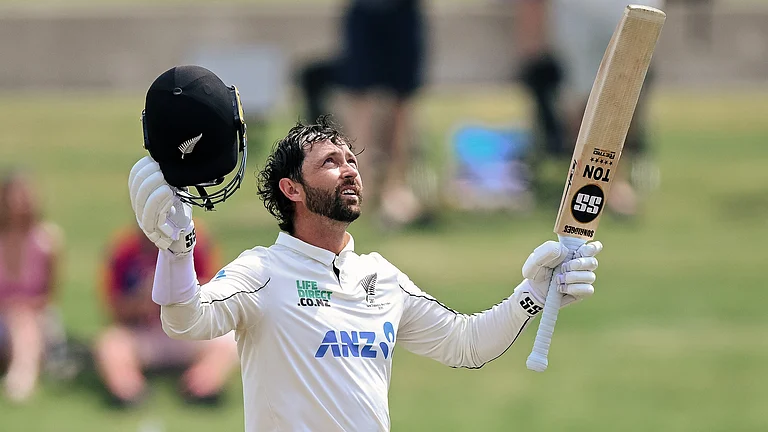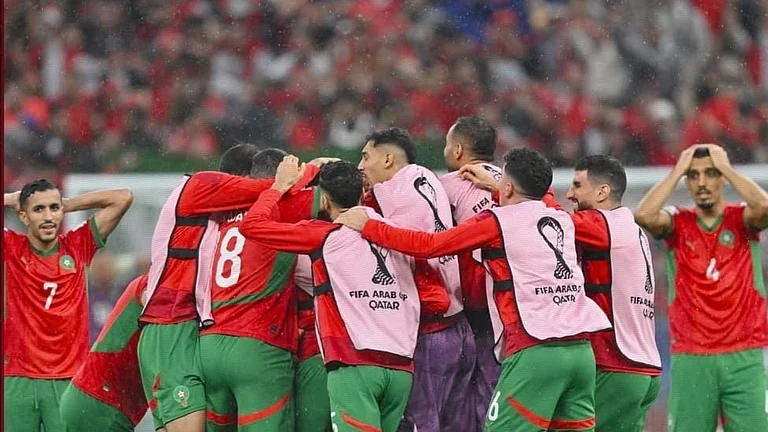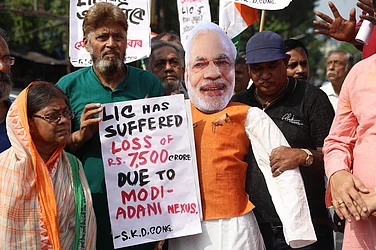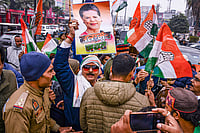Two sets of white and red flags flutter in the wind in the courtyard of a house where a man claims to have healing capabilities. Lohardaga district’s Sukumar village, located at a distance of over 75 km from Jharkhand’s capital, Ranchi, is home to the man recently summoned by the police after a woman was declared a witch and killed in a neighbouring village and warned against branding someone. Often referred to as ojhas, ojhain, bhagtain, guni, tantric, these men are considered traditional healers who also have the power to brand someone a witch. 56-year-old Gaurang Oraon (first name changed upon request) is an ojha, says that the flags symbolise a set of parents, the yellow one represents the healing powers of turmeric and the teachings of a guru (coach) and the green flag embodies nature, trees, and greenery. “These flags are my aerial source of power, just as antennae are for television signals,” he says.
The grand-nephew of a sorceress, Oraon claims to have the ability to touch and identify if someone is a dayan (witch) by calling out the names of castes and subcastes. “Teliya, Masaan, Khadiya, Bengalin, Rajput, Kumharin, Mishrayin, Jolhi, Lohrayin, Thakur, Munda, Nauwa, Asur, Domin, Chamarin, Birhor, Keta, Mallah.
After he was summoned by the Bada babu (Station House Officer) of the nearby police station along with other ojhas and bhagats after a woman was murdered in a neighbouring village on charges of being a dayan, he says he is being careful. While the community and villagers believe Oraon and other bhagats, the administration is sceptical of them.
Oraon’s story of becoming a witch doctor began in 2005 when he was shot in the chest in 2005 after being confused for another bhagat. Oraon was rushed to the hospital in Kuru village, around 16 km from his own village. “I was done for; it was the Almighty that saved me,” he says, revealing the scar left by the gunshot between his chest and left shoulder.
Oraon begins to tell the story of how one becomes a sorcerer. “There are distinct ojhas, gunis or bhagats. Some live a lavish life, while others choose simpler lives. There are also the likes of me, who never received any formal training or learned through manuscripts or books.” He became a sorcerer around 2003 and had to quit non-vegetarian food and intoxicants. Oraon says that “He”(the power) spoke to Gaurang and forbade him from consuming meat or alcohol. “I ended up eating goat meat one day. I was restless the entire day and experienced the power speaking to me and punishing me. He spoke to me and warned me of repeating my actions. I have redeemed myself since.”
He describes experiencing the power entering him as a very strong force that takes over his consciousness. Oraon is not the first ‘good witch’ of his family. He continues the legacy of a grand aunt who was also an accomplished sorceress according to the villagers. “The grand-aunt had no children. I would watch her perform her rituals. She blessed me by making me her successor,” Oraon says.
If anyone visits a bhagat with their issues, they must come with rice. This rice is both an offering and an essential to perform any ritual in order to identify the problem of the clients. “I first ask my deity, look at the rice, offer it, and spread it in the north and west winds.” It is after this reading of the rice and chanting the mantras that the bhagat throws hints at the problems of the clients who have come seeking help, asking if it is the case with them. “In case of an evil eye, I ward them off, resolving it before any severe ramifications,” he says. The evil or enemy is cast off through the ritual of ‘ghar bandhna’, (protecting the house) through a set of mantras. Oraon does this as he speaks with the spirits himself, asking what they want and what would they take to leave his clients.
I inform him about my damaged knee which has obstructed regular movement for over five months. After some hesitation and reluctance, he agrees to take a look at my problem. Since I carry no rice of my own, the bhagat uses a different method to identify my problem and come up with his diagnosis. He takes my hand and starts speaking with the spirits and forces. “Shree Ram! Hey Dharti! Hey Bhagwan! Hey Dharti! Hey Bhagwan! Swati ke naam se le kar sab grah kaait de. Kane se grah alag, kane se rog alag, ki kane se kalank alag. Hum manukh ke nahin doshi banaab, dharti ke doshi banaab. janam karam diya hain, E sab grah kiaait de, nav grah kait de” he chants, as his mantras fade into incomprehensible utterances. The bhagat now begins to speak more clearly, as he tightens his grip on my wrist, “Sahi sahi batao. sahi sahi maaloom ho gaya. sahi sahi batao.”
Later, he tells me that my treatment would take some time. “Different people and different diseases require different methods. The doctor doesn’t treat all his patients with the same medicine,” he smiles. He also hints, after some prodding, that my ailments could be a result of some sort of black magic or evil eye caused by a relative or neighbour.
I ask him how one differentiates a good witch from a bad witch and how one becomes a witch. “Our mantras are different from those of the dayans. The witches’ ways of learning are also different. Some get the powers naturally; others are born with them. Some learn at different places, often a kabristan (graveyard), in the forest, or by the river.” The bhagat believes that some dayans come learned and trained while some become victims of black magic by in-laws or relatives, mostly women, as he uses a female term to describe these relatives- nanad, gotni, saas; etc.
He only asks for a sacrificial animal, sweets, ghee (butter) or other things when the spirits have demanded it.


























